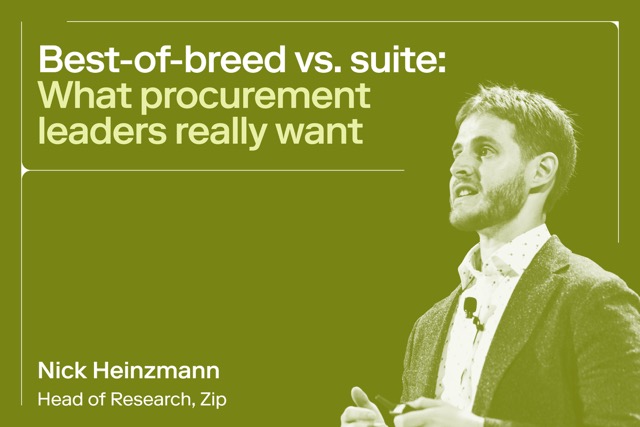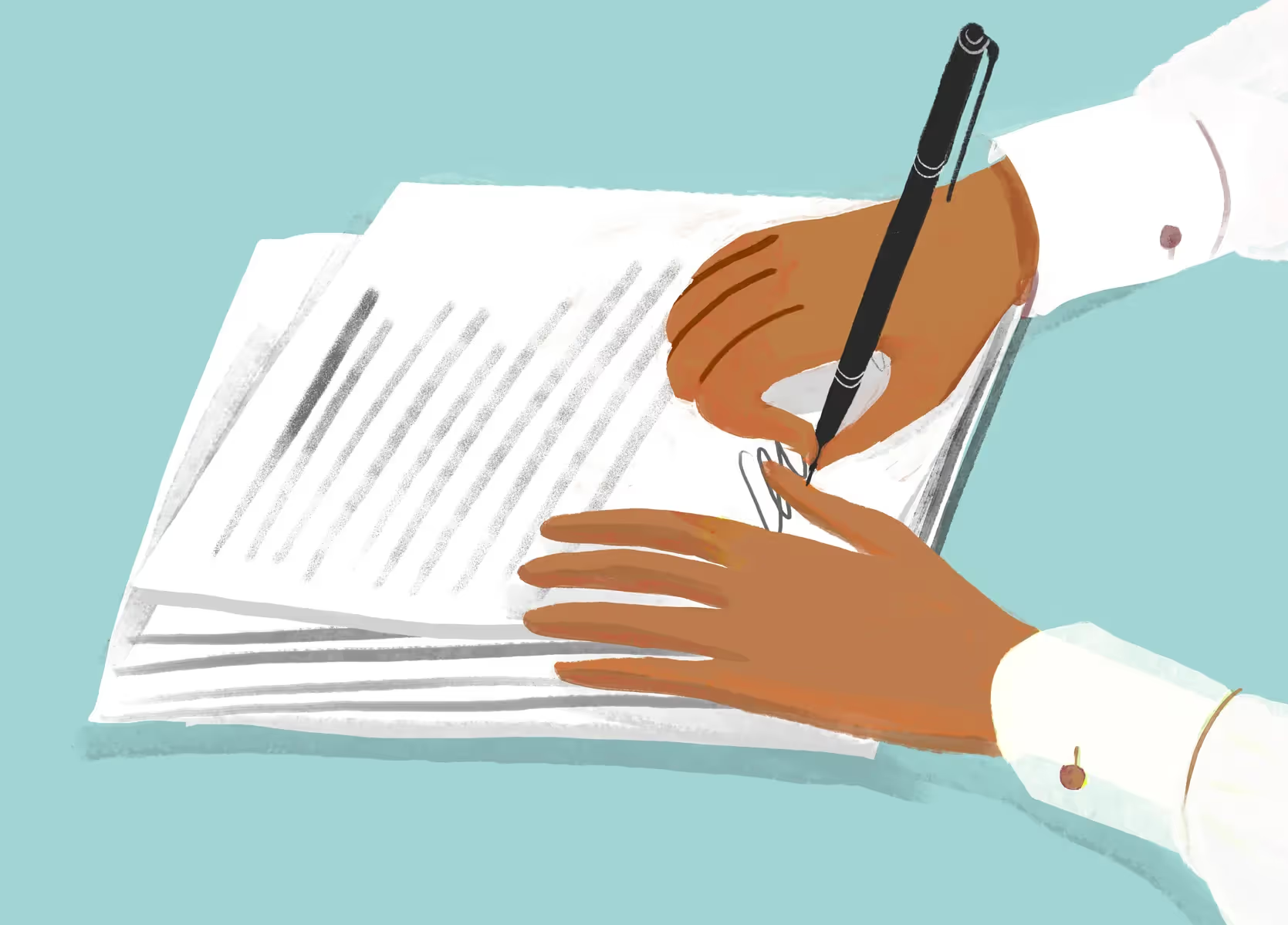
Purchase Order process: Definition & steps to automate
Learn the purchase order process and accelerate business with Zip orchestration.

In procurement, where technology often promises efficiency yet often delivers complexity, one insight rings true across the function: mastering the basics is essential.
Nick Heinzmann, Head of Research at Zip noted this in his monthly newsletter when he said: “This is a theme I have heard repeatedly in the last year working with Zip customers and prospects exploring the intake management market. They had made hefty investments in procuretech solutions hoping to transform their organizations, only to stumble on the fundamentals.”
It’s true—the foundational building blocks of procurement will always remain constant, no matter what level of growth or scale your company finds itself in.
Let’s take a look at how the purchase order process works, and how your teams can build upon this foundation to accelerate workflows with a procurement orchestration platform Zip.
10 steps of the purchase order process
The purchase order process and its associated workflows can be intricate, and can vary across companies. However, there is a common framework, delineating the path post- initial ‘need identification’ up through fulfillment. Understanding this process is essential for any organization looking to streamline procurement operations.
Here is a breakdown of the most common steps:
Create a Purchase Order
The journey begins with the creation of a purchase order (PO), a document that formally outlines the buyer's intent to purchase specific goods or services from a supplier. This step converts the need into an actionable request, detailing quantities, descriptions, and prices, serving as the foundation for the procurement process.
Send out Requests for Quotation (RFQ)
Depending on the organization's procurement policy, the next step might involve sending out RFQs to multiple suppliers. This optional phase allows buyers to solicit bids from various vendors, ensuring competitive pricing and terms for the required goods or services.
Identify and select vendors
After receiving quotations, the procurement team evaluates potential suppliers based on criteria such as cost, quality, delivery timelines, and service history. This critical step ensures that the organization partners with the best-fit vendor for its specific needs.
Negotiate and approve contract
Once a vendor is selected, the next phase involves negotiating terms and conditions that govern the purchase. This includes pricing, delivery schedules, payment terms, and warranties. After both parties reach an agreement, the contract is formally approved, solidifying the terms of engagement.
Send Purchase Order
With the contract approved, the official purchase order is sent to the vendor. This document confirms the buyer's intent to purchase the goods or services under the agreed-upon terms, acting as a legally binding commitment.
Delivery of goods/services
The vendor proceeds to fulfill the order by delivering the specified goods or services. This step is crucial as it transitions the process from a contractual agreement to the practical receipt of the ordered items.
3-way match
Before proceeding with payment, the procurement team conducts a 3-way match, verifying that the purchase order, the delivery receipt, and the vendor's invoice align. This step is essential for ensuring accuracy and preventing discrepancies, forming a check against overcharging or incorrect deliveries.
Approve invoice and send payment
Once the 3-way match is confirmed, the invoice is approved for payment. This step culminates the financial transaction, with the organization settling the invoice according to the previously agreed-upon payment terms.
Record and update data
Accurate record-keeping is vital throughout the purchase order process, but especially so after payment. This step involves updating financial records and inventory management systems to reflect the new purchase, ensuring data integrity and facilitating future audits.
Closure
The final step marks the closure of the purchase order process. It involves confirming that all contractual obligations have been met, goods or services have been received and are satisfactory, and payment has been completed. This step officially concludes the transaction, allowing both parties to move on to future engagements.
Why is the purchase order process important?
The purchase order process often acts as the linchpin that holds procurement supply chain operations together. Despite its importance, the PO process is frequently bogged down by inefficiencies that can significantly hinder a business’s ability to operate smoothly.
An inefficient purchase order process can be a major bottleneck, leading to a cascade of negative consequences. Manual processing, characterized by paper-based orders, manual entries, and physical signatures, not only slows down operations but also increases the likelihood of errors. These inefficiencies can result in incorrect orders, delayed deliveries, and disputes with suppliers, all of which can disrupt the supply chain and impact the bottom line.
Additionally, relying on complicated legacy systems can add layers of unnecessary work, forcing employees to navigate cumbersome interfaces and outdated procedures. This not only wastes valuable time and resources but also detracts from employees' ability to engage in more strategic, value-adding tasks.
The drawbacks of manual PO processing and outdated systems is what leads companies to consider modern procurement platforms, leveraging digitization and automation to streamline these processes throughout the entire procurement cycle. Automation ensures that purchase orders are processed quickly and accurately, allowing for real-time tracking and management. Digitization, on the other hand, facilitates the easy storage and retrieval of purchase order documents, making it simpler to review historical data and make informed decisions.
A successful purchase order process is not just about avoiding inefficiencies; it’s about enabling businesses to get what they need, when they need it, ensuring seamless operations. This operational fluidity is essential for maintaining a competitive edge in today’s fast-paced market environment.
Efficient PO processing ensures that goods and services are delivered on time, inventory levels are optimal, and production schedules are uninterrupted, thereby minimizing downtime and maximizing productivity.
Purchase Order vs. Purchase Requisition vs. Invoice: What’s the difference?
Purchase orders, purchase requisitions, and invoices are documents that serve as the backbone of procurement processes, ensuring that operations run smoothly and efficiently. But what’s the difference?
Let’s take a look at the definitions and differences between these three important documents, and the way they work within the overall purchase order process.
What is a Purchase Order?
A purchase order (PO) is essentially a formal proposal issued by a buyer to a vendor, signaling the intent to purchase certain goods or services under specified terms. It is a legally binding contract that outlines the specifics of the purchase, including the types and quantities of goods or services, pricing, payment terms, and delivery requirements.
The issuance of a purchase order marks a commitment on the part of the buyer to pay for the goods or services requested, contingent upon delivery by the vendor as per the agreement. This document safeguards both parties by clearly delineating the expectations and obligations of the transaction.
What is a Purchase Requisition?
In contrast to the binding nature of a purchase order, a purchase requisition is an internal document generated within an organization, signifying the initial step in the procurement process. It is essentially a request made by a department or individual to the organization's purchasing department for the acquisition of goods or services.
This document is not legally binding with external vendors; instead, it serves as a formal request for approval within the organization before a purchase order is issued to a vendor. The purchase requisition includes details about the requested items, such as descriptions, quantities, and justifications for the purchase, facilitating internal review and approval processes to ensure the request aligns with budgetary constraints and organizational needs.
What is an Invoice?
Once goods or services are delivered, the vendor issues an invoice to the buying organization. This document is a request for payment, detailing the goods or services provided, their quantities, and the agreed-upon prices as outlined in the purchase order.
An invoice is thus the vendor's bill to the buyer, signaling the completion of the delivery and the commencement of the payment obligation based on the terms previously agreed upon. It is crucial for the buying organization to verify the accuracy of the invoice against the purchase order and the goods or services received before processing payment, ensuring that all aspects of the transaction align.
What’s included in a purchase order?
While the specifics of a purchase order can vary widely across different industries and companies, there are standard pieces of information that are commonly included to ensure clarity, legality, and efficiency in the transaction. Let’s take a look at a short breakdown of the standard information included in a purchase order.
- Buyer’s contact information: Includes the name, address, and contact details of the organization making the purchase.
- Vendor’s contact information: Contains the name, address, and contact details of the supplier or service provider.
- Issue date: The date on which the purchase order is issued by the buyer.
- Purchase order number: A unique identifier for the purchase order, used for tracking and reference purposes.
- Order details: Specifics about the goods or services being purchased, including descriptions, quantities, pricing, and the total amount of the order.
- Desired delivery date: The date by which the buyer wishes to receive the goods or services.
- Additional delivery instructions: Any special instructions regarding the delivery, such as the delivery location, method, or handling requirements.
- Payment terms: Details about how and when the vendor will be paid, including payment methods and timelines.
- Billing information: Information necessary for processing the payment, such as billing address and tax IDs.
- Additional terms and conditions: Any other terms and conditions agreed upon by both parties, possibly covering warranty, returns, or cancellation policies.
- Signatures: Signatures from authorized representatives of both the buyer and the vendor, making the document legally binding.
- Supporting attachments: Any additional documents that support the purchase order, such as quotes, specifications, or contracts.
With these elements, a PO becomes a comprehensive document that clearly communicates the expectations and agreements between a buyer and a vendor.
What are the main types of Purchase Orders?
While the basic purpose of a purchase order remains constant—to provide a legal contract for the purchase—there are different types of POs used to accommodate various purchasing scenarios. Here are the most common types of purchase orders:
Standard PO
This is the most frequently used type of purchase order and includes all the necessary details about the goods or services being purchased. It specifies the quantities, descriptions, prices, and other relevant information for a one-time purchase. Standard POs are typically used when all details about the purchase are known upfront, making them straightforward and clear for both parties.
Blanket PO
Used for ongoing purchases, a blanket purchase order covers multiple deliveries over a set period, often at negotiated prices. It's beneficial for buyers and vendors with a long-term relationship, reducing the need for issuing multiple standard POs. Blanket POs specify the total amount of goods or services the company intends to buy over time, but individual delivery dates and sometimes specific item quantities are not defined upfront.
Planned PO
Similar to blanket POs in that they establish a long-term agreement between a buyer and a vendor, planned purchase orders go one step further by outlining the organization’s intent to purchase certain goods or services. Unlike blanket POs, planned POs include estimates for future delivery dates and quantities, which can be finalized as actual requirements become clearer. This type of PO is useful for items with predictable consumption patterns but where specific delivery schedules are not immediately known.
Emergency PO
When unexpected needs arise, an emergency purchase order is issued to expedite the purchasing process. This type of PO bypasses some of the standard procurement procedures to ensure rapid delivery of goods or services, often in response to an urgent situation. While effective for addressing immediate needs, emergency POs may come with higher costs due to their expedited nature and the possible need for premium shipping or handling.
Purchase Order best practices
Without careful oversight and continuous improvement, the purchase order process can become a source of inefficiencies that can snowball into long-term issues, potentially harming vendor relationships and negatively impacting business operations.
Streamlining the purchase order process is not just about avoiding these pitfalls; it's about creating a foundation for operational excellence and strategic growth. Here are some best practices to ensure this process serves your business effectively.
- Regularly Review Your Current PO Process
Continuous improvement begins with regular reviews of your existing purchase order process. This involves assessing each step, from the initial creation of a purchase order to the final payment, to identify bottlenecks, redundancies, or areas lacking clarity. By understanding the current state of your process, you can make informed decisions on where improvements are needed.
- Identify Potential Points of Improvement, As Needed
Armed with insights from your review, pinpoint specific areas that require enhancement. Whether it’s reducing manual data entry, improving the accuracy of order details, or speeding up approval times, identifying these points of improvement is the first step towards a more efficient process.
- Outline and Standardize the PO Process
Variability can be the enemy of efficiency. By outlining and standardizing the purchase order process, you establish clear guidelines and expectations for everyone involved. This standardization can help reduce errors, streamline operations, and ensure consistency in how purchase orders are managed across the organization.
- Digitize and Automate Your PO Process
Leveraging technology to digitize and automate the purchase order process can lead to significant efficiencies. Automation reduces manual tasks, minimizes errors, and speeds up the entire process from purchase order creation to approval and beyond. Investing in procurement software or enterprise resource planning (ERP) systems can transform your PO process into a more efficient and accurate operation.
- Set and Track Actionable Goals
What gets measured gets managed. Setting specific, actionable goals for your purchase order process—such as reducing processing time, improving order accuracy, or enhancing vendor response times—allows you to track performance and make data-driven decisions. These metrics can serve as benchmarks for continuous improvement.
- Clearly Assign Tasks to Necessary Stakeholders
Clarity in roles and responsibilities ensures that each part of the purchase order process is handled efficiently. Make sure all stakeholders, from procurement specialists and department heads to finance teams, understand their roles in the process. Clear assignment of tasks helps prevent bottlenecks and ensures accountability.
- Keep Detailed and Accessible Records
Maintaining comprehensive records of purchase orders, vendor agreements, and related documents is crucial for accountability, auditing, and future reference. Ensure these records are organized and accessible, preferably through a centralized digital system that allows for easy retrieval and review.
- Create a List of Preferred Vendors
Developing and maintaining a list of preferred vendors can streamline the procurement process, ensuring you work with suppliers who meet your quality standards, delivery timelines, and price points. This list can also expedite the vendor selection process, reducing the time from need identification to order placement.
- Develop and Adhere to Set Budgets and Expense Groups
Effective financial management is integral to the purchase order process. Establishing budgets for different categories of goods and services—and ensuring purchase orders adhere to these budgets—helps maintain financial discipline and prevent cost overruns.
Common challenges to the purchase order process
Many challenges to the purchase order process step from reliance on manual processes and outdated systems, which can introduce inefficiencies and errors into the procurement process. Understanding these common hurdles is the first step toward addressing and overcoming them, ensuring a streamlined purchase order process.
Lost or Delayed Purchase Orders
One of the most immediate issues with a manual or outdated purchase order system is the tendency for purchase orders to get lost or delayed. Paper-based processes or unsophisticated digital solutions can lead to misplaced documents or slow transmission of orders to vendors, resulting in delays that disrupt the supply chain and operational timelines.
Slow Approval Workflows
Inefficient approval workflows can significantly slow down the purchase order process. Manual approvals require physical signatures or in-person meetings, which are not always feasible, leading to bottlenecks. Without a streamlined approval process, critical orders can be held up, delaying project timelines and impacting productivity.
Confusing or Non-standardized Purchase Order Process Guidelines
The lack of standardized guidelines for creating and processing purchase orders can lead to confusion among employees and vendors. Inconsistencies in order formatting, submission, and approval processes can result in errors and miscommunications, affecting the accuracy and efficiency of orders.
Miscommunications
Effective communication is vital in the purchase order process, yet miscommunications are common. Misunderstandings regarding order specifications, delivery timelines, or terms and conditions can arise from poorly managed communication channels, leading to errors and dissatisfaction for both the buyer and the vendor.
Increased Risk of Procurement Fraud
Manual and outdated purchase order processes are more susceptible to procurement fraud due to a lack of oversight and control. The absence of robust verification processes and audit trails makes it easier for fraudulent activities to go undetected, posing significant financial and reputational risks to the company.
Siloed Procurement Data
Operating in silos, where procurement data is not integrated with other business systems, can lead to inefficiencies and a lack of visibility into the procurement process. Without a unified view of procurement activities, businesses may struggle with inventory management, spend analysis, and strategic planning, impacting the overall efficiency and cost-effectiveness of the procurement function.
Addressing these challenges requires a comprehensive approach to modernizing and streamlining the purchase order process.
Leveraging a procurement orchestration platform like Zip can automate and digitize procurement processes can significantly mitigate these issues, leading to improved efficiency, enhanced transparency, and stronger vendor relationships.
Automating the purchase order process with Zip
The procurement industry is moving fast, and it’s more important than ever to ensure efficiency and accuracy in every process. The manual handling of purchase orders can be a significant bottleneck, prone to human error and miscommunications that can delay operations and strain vendor relationships. This is where purchase order process automation comes into play, transforming the way organizations manage their procurement activities.
What is purchase order process automation?
Purchase order process automation involves using software to digitize and streamline every step of the purchase order process, from creation and approval to delivery and reconciliation. By automating these processes, organizations can significantly reduce manual tasks that are susceptible to error, thereby enhancing efficiency, accuracy, and speed.
Capabilities of an automated purchase order process
An effective purchase order automation solution, like Zip, can revolutionize procurement processes in several ways:
- Streamline purchase requisition process: By automating requisitions, businesses can ensure that purchase requests are processed more quickly and efficiently, with automatic routing for approval based on predefined workflows.
- Speed up approval workflows: Zip allows for instant notification and electronic approval of purchase orders, significantly reducing the time it takes to get sign-offs. When fewer people are waiting for approvals,
- Automatically send documents to relevant stakeholders: With Zip automations, all necessary documentation can be automatically forwarded to the relevant parties, including vendors, finance teams, and inventory management. This ensures everyone is on the same page and significantly reduces the chances of miscommunication.
Introducing Zip's purchase order process capabilities
Zip offers an advanced solution for automating the purchase order process, designed to meet the needs of modern procurement functions. With Zip, organizations can take advantage of a comprehensive suite of tools tailored to enhance procurement efficiency.
Zip's platform is intuitive, integrating seamlessly with existing systems to provide a unified, streamlined procurement process from intake to pay. From simplifying the purchase requisition flow to enabling rapid approvals and facilitating effortless communication with vendors, Zip transforms procurement into a strategic asset for your business.
Elevate your procurement strategy with Zip
Automating the purchase order process with Zip not only streamlines operations but also unlocks significant value for businesses by reducing costs, minimizing errors, and improving vendor relationships. As organizations look to the future, the ability to adapt and enhance procurement processes with solutions like Zip will be a key differentiator in achieving operational excellence.
Discover how Zip can transform your purchase order process. Request a demo today and take the first step towards a more efficient, automated procurement process that drives business forward.

Maximize the ROI of your business spend

Enter your business email to keep reading



























.webp)




















.avif)













.avif)










.webp)





.avif)











.avif)
